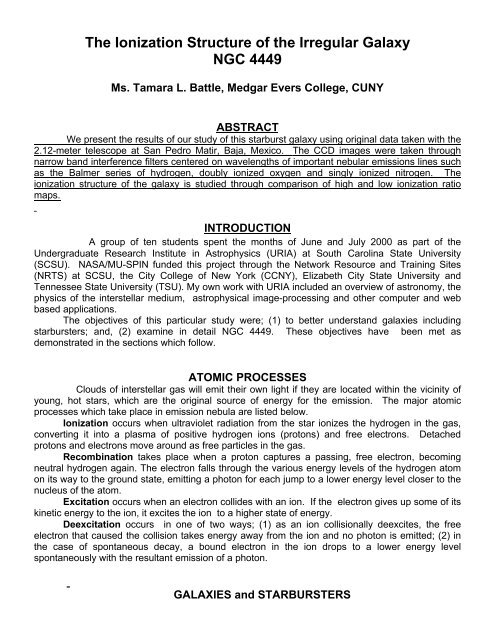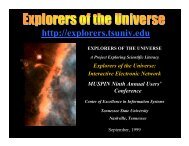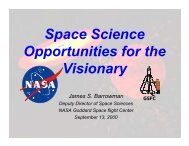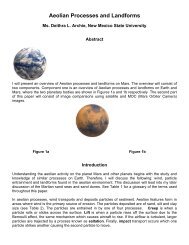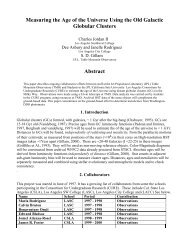The Ionization Structure of the Irregular Galaxy ... - Mu-SPIN - NASA
The Ionization Structure of the Irregular Galaxy ... - Mu-SPIN - NASA
The Ionization Structure of the Irregular Galaxy ... - Mu-SPIN - NASA
Create successful ePaper yourself
Turn your PDF publications into a flip-book with our unique Google optimized e-Paper software.
<strong>The</strong> <strong>Ionization</strong> <strong>Structure</strong> <strong>of</strong> <strong>the</strong> <strong>Irregular</strong> <strong>Galaxy</strong><br />
NGC 4449<br />
Ms. Tamara L. Battle, Medgar Evers College, CUNY<br />
ABSTRACT<br />
We present <strong>the</strong> results <strong>of</strong> our study <strong>of</strong> this starburst galaxy using original data taken with <strong>the</strong><br />
2.12-meter telescope at San Pedro Matir, Baja, Mexico. <strong>The</strong> CCD images were taken through<br />
narrow band interference filters centered on wavelengths <strong>of</strong> important nebular emissions lines such<br />
as <strong>the</strong> Balmer series <strong>of</strong> hydrogen, doubly ionized oxygen and singly ionized nitrogen. <strong>The</strong><br />
ionization structure <strong>of</strong> <strong>the</strong> galaxy is studied through comparison <strong>of</strong> high and low ionization ratio<br />
maps.<br />
INTRODUCTION<br />
A group <strong>of</strong> ten students spent <strong>the</strong> months <strong>of</strong> June and July 2000 as part <strong>of</strong> <strong>the</strong><br />
Undergraduate Research Institute in Astrophysics (URIA) at South Carolina State University<br />
(SCSU). <strong>NASA</strong>/MU-<strong>SPIN</strong> funded this project through <strong>the</strong> Network Resource and Training Sites<br />
(NRTS) at SCSU, <strong>the</strong> City College <strong>of</strong> New York (CCNY), Elizabeth City State University and<br />
Tennessee State University (TSU). My own work with URIA included an overview <strong>of</strong> astronomy, <strong>the</strong><br />
physics <strong>of</strong> <strong>the</strong> interstellar medium, astrophysical image-processing and o<strong>the</strong>r computer and web<br />
based applications.<br />
<strong>The</strong> objectives <strong>of</strong> this particular study were; (1) to better understand galaxies including<br />
starbursters; and, (2) examine in detail NGC 4449. <strong>The</strong>se objectives have been met as<br />
demonstrated in <strong>the</strong> sections which follow.<br />
ATOMIC PROCESSES<br />
Clouds <strong>of</strong> interstellar gas will emit <strong>the</strong>ir own light if <strong>the</strong>y are located within <strong>the</strong> vicinity <strong>of</strong><br />
young, hot stars, which are <strong>the</strong> original source <strong>of</strong> energy for <strong>the</strong> emission. <strong>The</strong> major atomic<br />
processes which take place in emission nebula are listed below.<br />
<strong>Ionization</strong> occurs when ultraviolet radiation from <strong>the</strong> star ionizes <strong>the</strong> hydrogen in <strong>the</strong> gas,<br />
converting it into a plasma <strong>of</strong> positive hydrogen ions (protons) and free electrons. Detached<br />
protons and electrons move around as free particles in <strong>the</strong> gas.<br />
Recombination takes place when a proton captures a passing, free electron, becoming<br />
neutral hydrogen again. <strong>The</strong> electron falls through <strong>the</strong> various energy levels <strong>of</strong> <strong>the</strong> hydrogen atom<br />
on its way to <strong>the</strong> ground state, emitting a photon for each jump to a lower energy level closer to <strong>the</strong><br />
nucleus <strong>of</strong> <strong>the</strong> atom.<br />
Excitation occurs when an electron collides with an ion. If <strong>the</strong> electron gives up some <strong>of</strong> its<br />
kinetic energy to <strong>the</strong> ion, it excites <strong>the</strong> ion to a higher state <strong>of</strong> energy.<br />
Deexcitation occurs in one <strong>of</strong> two ways; (1) as an ion collisionally deexcites, <strong>the</strong> free<br />
electron that caused <strong>the</strong> collision takes energy away from <strong>the</strong> ion and no photon is emitted; (2) in<br />
<strong>the</strong> case <strong>of</strong> spontaneous decay, a bound electron in <strong>the</strong> ion drops to a lower energy level<br />
spontaneously with <strong>the</strong> resultant emission <strong>of</strong> a photon.<br />
GALAXIES and STARBURSTERS
Galaxies are gravitationally bound aggregations <strong>of</strong> stars, gas and dust. In <strong>the</strong> 1920's, Edwin<br />
Hubble classified galaxies by <strong>the</strong>ir shape into three major types, spiral, elliptical and irregular.<br />
Examples are shown in Figures 1a, b and c. More details about galaxies can be found in <strong>the</strong> article<br />
from this conference by K. Banks and I. Lister.<br />
A galaxy which belongs to one <strong>of</strong> <strong>the</strong>se three types may also belong to a subtype known as<br />
a starburst galaxy. Starburst galaxies are <strong>the</strong> site <strong>of</strong> an ongoing or recent dramatic rise in <strong>the</strong> rate<br />
<strong>of</strong> star formation. A normal, non-starburst, spiral galaxy will form 1-10 solar masses per year.<br />
Estimates for star formation rates for a starburst galaxy during a burst range from 10-300 solar<br />
masses per year and possibly as much as 1000 solar masses per year in a very massive galaxy.<br />
A sudden increase in <strong>the</strong> star formation rate also results in an increase in <strong>the</strong> supernovae<br />
rate and <strong>the</strong> amount <strong>of</strong> energy imparted to <strong>the</strong> interstellar medium by high-speed winds from<br />
young, massive stars. Thus, a starburst galaxy <strong>of</strong>ten has a galactic wind, which pushes material up<br />
and out <strong>of</strong> <strong>the</strong> plane <strong>of</strong> <strong>the</strong> galaxy. Starbursters <strong>of</strong>ten display superbubbles and large arcs <strong>of</strong><br />
ionized gas, which are expanding outward to escape <strong>the</strong> home galaxy.<br />
Figure 1a: A spiral galaxy Figure 1b: An elliptical galaxy<br />
Figure 1c: An irregular galaxy Figure 2: NGC 4449<br />
NGC 4449<br />
<strong>The</strong> irregular galaxy NGC 4449 is an example <strong>of</strong> a starburster. This object is relatively<br />
nearby at a distance <strong>of</strong> only 5 megaparsecs. Table 1 includes some information about this object.<br />
In Figure 2 <strong>the</strong> red glow in NGC 4449 is from <strong>the</strong> hydrogen balmer emission line which originates in<br />
<strong>the</strong> gaseous nebulae. Perhaps <strong>the</strong> most striking feature <strong>of</strong> this galaxy is <strong>the</strong> incredible number <strong>of</strong><br />
star forming regions. What appears as stars in Figure 2 are actually clusters, each <strong>of</strong> which contain<br />
hundreds <strong>of</strong> stars ionizing a very large region <strong>of</strong> surrounding interstellar gas known as a Giant<br />
Extragalactic H II Region (GHER). <strong>The</strong> GEHR is what looks like a star.
HII REGIONS and GHERs<br />
An H II region is a zone <strong>of</strong> gas in which all <strong>of</strong> <strong>the</strong> hydrogen gas present is ionized. H II<br />
regions characteristically include several bright, hot stars whose ultraviolet radiation is converted to<br />
visible light as described earlier. A typical H II region in our galaxy has a diameter <strong>of</strong> a few<br />
parsecs, a gas temperature <strong>of</strong> 10,000 K with a density <strong>of</strong> about 100 to 10,000 particles/cm 3 .<br />
GEHRs are ionized hydrogen regions as well but on a much grander scale. <strong>The</strong>y are most<br />
4 5<br />
commonly characterized by diameters greater than 100 pc, a total ionized gas mass <strong>of</strong> 10 -10 Mסּ,<br />
and an average density <strong>of</strong> 1-10 particles/cm 3 . Typically one finds 100 to 200 ionizing stars within a<br />
GEHR.<br />
DATA REDUCTION and RESULTS<br />
<strong>The</strong> data for this research project came from <strong>the</strong> observations taken at <strong>the</strong> San Pedro Matir<br />
Observatory in Baja, Mexico in June 1994. Table 2 includes information on <strong>the</strong> specific images<br />
used in this study. For image processing, we utilized <strong>the</strong> IRAF s<strong>of</strong>tware package to remove noise<br />
sources and to create our ratio maps. For more information on CCD noise see <strong>the</strong> article at this<br />
meeting by B. Teasdel; for details on IRAF and image processing, see <strong>the</strong> paper by K. Banks and<br />
I. Lister.<br />
Figure 3: OIII/Hβ Ratio Map Figure 4: NII/Hα Ratio Map<br />
Figure 3 is a ratio map in which our image taken with <strong>the</strong> [O III] filter at 5007 Å was divided<br />
by <strong>the</strong> image take through <strong>the</strong> Hβ filter at 4861 Å. <strong>The</strong> dark areas are regions <strong>of</strong> high ratio values<br />
<strong>of</strong> 3.0–3.5 which correspond to high ionization regions at <strong>the</strong> center <strong>of</strong> <strong>the</strong> GEHR, closest to <strong>the</strong><br />
cluster <strong>of</strong> ionizing stars.<br />
Figure 4 is also a ratio map in which <strong>the</strong> image taken <strong>of</strong> <strong>the</strong> [N II] line at 6584 Å was divided<br />
by <strong>the</strong> image taken through <strong>the</strong> Hα line at 6563 Å. <strong>The</strong> dark areas have large [NII]/Hα values <strong>of</strong><br />
around 0.2. <strong>The</strong>se are <strong>the</strong> low ionization regions in and between adjacent GEHRs. <strong>The</strong> low<br />
ionization regions cover a larger area <strong>of</strong> each GEHR, which is obvious when comparing <strong>the</strong> size <strong>of</strong><br />
each GEHR in both Figure 3 and 4. Fur<strong>the</strong>rmore, <strong>the</strong> fact that Figure 4 shows far more ionization<br />
between <strong>the</strong> GEHRs than in Figure 3 confirms that most <strong>of</strong> <strong>the</strong> high energy photons are absorbed<br />
in <strong>the</strong> inner part <strong>of</strong> <strong>the</strong> GEHRs leaving only low energy photons to travel fur<strong>the</strong>r out into <strong>the</strong> galaxy.<br />
SUMMARY
<strong>The</strong> four major atomic processes which occur in gaseous nebulae have been discussed.<br />
<strong>The</strong>se processes form <strong>the</strong> foundation for understanding <strong>the</strong> nature <strong>of</strong> H II regions, GEHRs and <strong>the</strong><br />
interstellar medium in galaxies. New ground-based imagery <strong>of</strong> NGC 4449 has been processed and<br />
are ready for fur<strong>the</strong>r study.<br />
ACKNOWLEDGEMENTS<br />
We wish to acknowledge funding for this research from <strong>NASA</strong> to Medgar Evers College<br />
through its PAIR and Partnership awards and from <strong>NASA</strong>/MU-<strong>SPIN</strong> through NCC 5-98 to <strong>the</strong><br />
CCNY, NCC 5-116 to SCSU and NCC 5-228 from <strong>NASA</strong>-URC to TSU. <strong>The</strong> author also wishes to<br />
thank Dr. Leon Johnson at Medgar Evers, Dr. Shermane Austin at CCNY and Dr. Donald Walter at<br />
SCSU.<br />
Bishop, Roy 1998, Observer's Handbook 1998<br />
REFERENCES<br />
Hirshfeld, Alan & Sinnott, Roger W. 1998, Sky Catalogue 2000.0, Volume 2.<br />
Kennicutt, R.C. 1983, Astrophysical Journal, 272, 54<br />
Telesco, Charles 1988, Annual Review <strong>of</strong> Astronomy and Astrophysics, 26, 343<br />
TABLE 1<br />
Properties <strong>of</strong> NGC 4449<br />
<strong>Galaxy</strong> Type Magellanic <strong>Irregular</strong><br />
DDO Luminosity III<br />
Right Ascension (α 2000.0) 12 h 28.2 m<br />
Declination (δ 2000.0) +44° 06´<br />
Constellation Canes Venatici<br />
Distance 5.0 Mpc<br />
Size Major diameter 5.1’ (angular), 7.42 kpc (linear)<br />
Size Minor diameter 3.7’ (angular), 5.38 kpc (linear)<br />
B (Blue) Magnitude 9.85<br />
V (Visual) Magnitude 9.44<br />
B-V (Color Index) 0.41<br />
Radial Velocity +262 km/s
TABLE 2<br />
SPM Data Log for NGC 4449<br />
Image Name Filter Central λ Ion <strong>Ionization</strong> Potential<br />
n4n44003 6563 Å H II 13.6 eV<br />
n4n44013 6584 Å N II 14.5 eV<br />
n3n44005 5007 Å O III 35.1 eV<br />
n3n44006 4861 Å H II 13.6 eV


